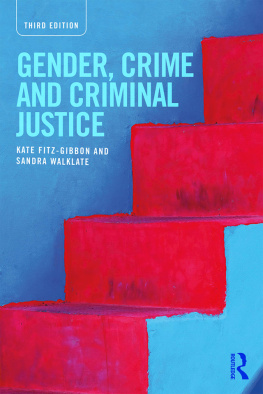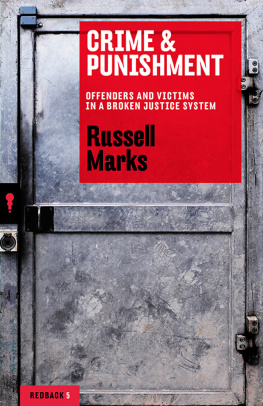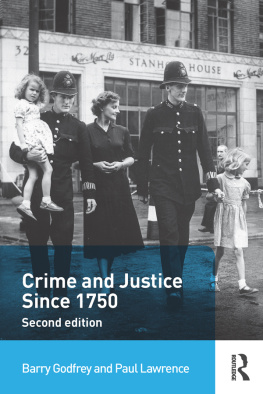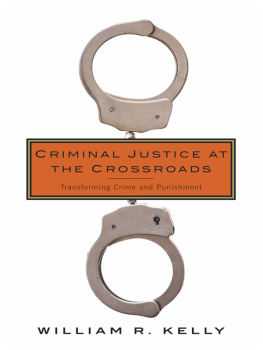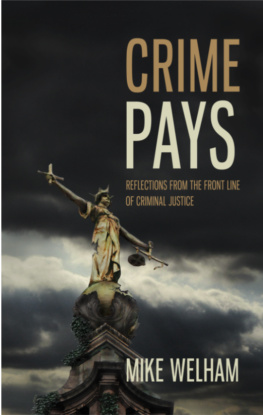
T HE C OMMUNITY J USTICE I DEAL
CRIME AND SOCIETY
Series Editor
John Hagan, University of Toronto
E DITORIAL A DVISORY B OARD
John Braithwaite, Robert J. Bursik, Kathleen Daly, Malcolm M. Feeley, Jack Katz, Martha A. Myers, Robert J. Sampson, and Wesley G. Skogan
The Community Justice Ideal: Preventing Crime and Achieving Justice, Todd R. Clear and David R. Karp
Whistleblowing at Work: Tough Choices in Exposing Fraud, Waste, and Abuse on the Job, Terance D. Miethe
Losing Legitimacy: Street Crime and the Decline of Social Institutions in America, Gary LaFree
Casualties of Community Disorder: Women's Careers in Violent Crime, Deborah R. Baskin and Ira B. Sommers
Public Opinion, Crime, and Criminal Justice, Julian V. Roberts and Loretta Stalans
Poverty, Ethnicity, and Violent Crime, James F. Short
Great Pretenders: Pursuits and Careers of Persistent Thieves, Neal Shover
Crime and Public Policy: Putting Theory to Work, edited by Hugh D. Barlow
Control Balance: Toward a General Theory of Deviance, Charles R. Tittle
Rape and Society: Readings on the Problems of Sexual Assault, edited by Patricia Searles and Ronald J. Berger
T HE C OMMUNITY J USTICE I DEAL
Preventing Crime and Achieving Justice
T ODD R. C LEAR
John Jay College of Criminal Justice
D AVID R. K ARP
Skidmore College
Crime and Society
First published 1999 by Westview Press
Published 2018 by Routledge
711 Third Avenue, New York, NY 10017, USA
2 Park Square, Milton Park, Abingdon, Oxon OX14 4RN
Routledge is an imprint of the Taylor & Francis Group, an informa business
Copyright 1999 by Taylor & Francis
All rights reserved. No part of this book may be reprinted or reproduced or utilised in any form or by any electronic, mechanical, or other means, now known or hereafter invented, including photocopying and recording, or in any information storage or retrieval system, without permission in writing from the publishers.
Notice:
Product or corporate names may be trademarks or registered trademarks, and are used only for identification and explanation without intent to infringe.
A CIP catalog record for this book is available from the Library of Congress.
ISBN 13: 978-0-8133-6766-8 (pbk)
ISBN 13: 978-0-8133-6765-1 (hbk)
T HE C OMMUNITY J USTICE I DEAL
There is disquiet in America about what is happening to community life. Americans seem to have a sense that the quality of community life is diminishing and that family life is deteriorating. There is widespread talk about the need to "restore" the community and family, and many feel that a crisis of values is occurring in both the public and the private spheres of American life. Some of this is almost certainly nostalgia and sentimentalism. To the degree that the "community movement" is a romantic appeal to an inaccurate recollection of the past, it is an interlude destined for a short life.
But other, more objective indicators suggest that community life is indeed changing in America and that many citizens' concerns are justified. Some of these changes involve distance and technology: With our growing use of computers and involvement in international markets, the world is increasingly everyone's neighborhood. Other changes appear more rooted in socioeconomic trends; the increasing inequality and structural distance between social groups, combined with fewer intact families raising children, cause many observers to worry that the infrastructure of good citizenship is deteriorating. People move from place to place, and at every turn their children are confronted by technical, social, and interpersonal change. With our society undergoing such rapid transformation, people worry about whether the foundations of democratic life are strong enough to take us very far into the future.
These changes have enormous implications for criminal justice. As people begin to feel and express their alienation from institutional life, including political institutions, their actions cannot help but spill over into the formal mechanisms of social control. In a quarter century, the size, cost, and potency of the justice apparatus has grown three to five times over, depending on how one counts the growth. Public confidence in the justice system is, if anything, less than when the growth began. Surely if the justice system were put up for a vote of confidence, the prospects would be dim. One way of interpreting this situation is that people have little confidence that the justice system supports the quality of daily life.
The movement or criminal justice toward the community initiatives described in this book is a response to the common sense of dismay about community life. Criminal justice officials, sensing that confidence in their actions is slipping away have sought a closer alignment with community members partly as a vehicle for increasing faith in justice practices. It must also be remembered that criminal justice practitioners are also members of the community. They feel some of the same disillusionment in official policies and they experience the same type of yearning for a better quality of community life.
The disquiet about community life that has translated into a community movement in criminal justice has, to date, consisted of sporadic experiences and initiatives and has lacked a philosophy and a strategic modelan "ideal." This book is an attempt to fill that void. We address three main questions:
- What is the practical case for greater community involvement in criminal justice?
- What is the philosophical basis for community-oriented criminal justice?
- What might a community-oriented justice practice look like?
In discussing these questions, we do not pretend to offer any final resolutions. The analysis that follows is an attempt to organize the issues of community-oriented criminal justice in a way that makes sense, and to consider them systematically. We hope this discussion will stimulate others to analyze more deeply and critically the territory we have outlined.
There is no standard formula for a community justice program. The design of a particular community justice approach will depend upon the interlocking traditions of the neighborhood's community organizations, justice system practices, and crime problems. One way to illustrate the array of possibilities is through a description of one hypothetical neighborhood: Tocqueville Heights.
Community Justice in Tocqueville Heights
Tocqueville Heights is an old, inner-city neighborhood in the city of Megalopolis. Comprised of roughly 100 square blocks, Tocqueville Heights has three multistory public housing complexes and a small business section, and is served by a public school complex named Tocqueville Heights School. One-half of the residents have incomes under or just over the poverty line, and the area has high rates on all indicators of disorganization: single-parent families, high-school dropouts, unemployment, vacant dwellings, and public assistance. The area also is among the highest in arrest rates for drugs and street crimes.


